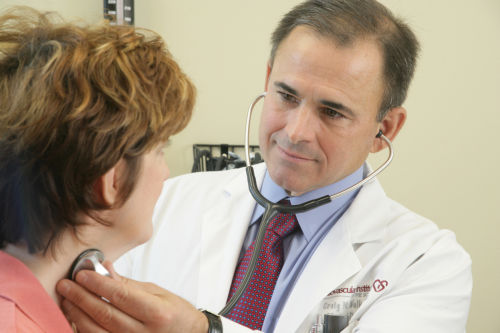The Obnoxious Sweater
October 1, 2013Crime Blotter: Reported offenses in the Tri-parishes
October 1, 2013Cardiovascular Institute of the South is working to bring attention to peripheral arterial disease, a largely unknown, often unrecognized disease during National PAD Awareness Month.
“Peripheral arterial disease is going to be a big healthcare problem,” said Dr. Craig Walker, founder, president and medical director at Cardiovascular Institute of the South. “PAD and heart attacks and strokes go hand in hand. PAD can push your heart to the breaking point. It will exceed the cost of cardiac care.”
Walker, who treats patients in Houma and in Lafayette, said the disease, which grows in the number of patients each year, is mostly prevalent among those over the age of 50 who smoke or have smoked and have diabetes, high blood pressure, high blood cholesterol or a personal or family history of vascular disease, heart attack or stroke. Also, black people are more than twice as likely to have PAD as caucasians. The disease is caused by the same risk factors that lead to heart disease.
The common – one in 20 Americans over the age of 50 has it – and treatable disease is caused by plaque build-up or blockages in the legs, neck or arms which can keep the brain and appendages from receiving blood. The disease can reduce mobility and be fatal if left untreated. PAD can be prevented by not smoking, keeping blood pressure and cholesterol levels down, regular exercise and controlling diabetes.
According to Walker, those who suffer from PAD may not recognize the disease’s symptoms which include an open ulcer or wound on the bottom of one or both feet that does not heal; pain in the feet or legs that goes away with walking; severe cramping in calves after exercising that goes away immediately after stopping; discoloration of the legs or feet; numbness or coldness in legs or feet and pale, shiny skin. The symptoms of PAD are often attributed to old age.
“Some patients will experience claudication – muscle cramps after golfing, walking or biking,” Walker said.
PAD can lead to gangrene in the legs and even amputation if not diagnosed and treated early enough, and people lose limbs each year to the disease. An ultrasound to test the blood flow in a patient’s legs can determine if someone is suffering from PAD, and CIS has vast experience in interventional procedures to prevent amputation.
“Treatment of PAD and the invasiness of treatments have changed,” Walker said. “Doctors have been treating PAD with bypasses since the 1950s. Now can treat a patient, and he or she can leave in a day or two.”
Today, CIS can treat PAD in four different ways. Those ways include the “balloon procedure,” which can be done alone or with a stent and is done via a needle stick, medication management and laser treatment. A bypass, performed by a surgeon, is used to treat the most severe cases of PAD.
In addition to treating patients from around the United State and from countries like Thailand, Europe, Latin America, Walker has also helped educate doctors from other countries and shown them techniques to treat PAD.
One of Walker’s patients who did not fit the age range for PAD is 28-year-old Angela Mullins of Ocean Springs, Miss.
“Angela had her first bypass at 21 years old,” Walker said. “By the time I met her, she was 27, and she had received three other doctors’ opinions before coming to me.”
Mullins began experiencing PAD symptoms as a teenager, mainly trouble with walking. The young woman was eventually treated for tendinitis and inflammation, but the symptoms continued until she eventually developed ulcers on her feet. The ulcers would not heal, and Mullins visited several more doctors for treatment as her symptoms worsened. By the time Mullins was properly diagnosed at the age of 21, she had blockages behind both of her knees and underwent bypass surgery on the appendages. While the surgery gave the young woman some relief, she was still experiencing pain.
In 2011, Mullins’ PAD symptoms returned. Her left foot turned purple, and she had the same ulcers and severe discoloration on her feet as she had before the bypass surgery.
“The pain was so unbearable, I could only sleep 30 minutes at a time before the pain woke me up,” Mullins said in a printed statement. “I couldn’t work or spend time at my son’s school activities.”
After visiting a doctor, Mullins was informed that both of her legs were blocked and her left leg had no blood flow. Following more doctors’ appointments, Mullins was told that amputating both of her legs was the only way to save her life.
“My family and I could not believe that amputation was the only answer, so in an effort to save my legs, I visited many doctors until I was referred to Cardiovascular Institute of the South in south Louisiana,” she said.
Following a series of three laser treatments performed by Walker, Mullins’ symptoms ceased and she began walking two miles a day. Mullins is now symptom and pain-free and can move around easily.
“I have gone back to work and can once again spend time with my son at school,” Mullins said. “I can even do things that I could not do right after my bypass surgery. I feel like I have my life back.”
Dr. Craig Walker, founder, president and medical director at Cardiovascular Institute of the South, conducts a check-up on a patient. CIS is working to bring attention to peripheral arterial disease, a largely unknown, often unrecognized disease, caused by caused by plaque build-up or blockages in the legs, neck or arms which can keep the brain and appendages from receiving blood.








